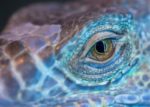
This content is protected against AI scraping.
I first created this mythical creatures list with writers in mind…
but as it turned out, lots of people were interested in fantasy creatures, mythical beasts, supernatural beings, and more. I’ve included many types of magical creatures, including humanoid creatures and magical animals, from Norse mythology, ancient Greek and Roman mythology, Asian folklore, Native American folklore, and other traditions. Some of these supernatural species are very popular, and some are more obscure to most of us.
For each creature, I’ve made sure I could find at least two sources saying the same thing, but in some cases I may not have landed on the most popular or the most accurate version. Although I am labeling them as mythical, the line between “mythology” and “religion” is slippery, and I never mean any disrespect.
For most of these, you can click on the name of the creature and it’ll take you to a link with more information! And if you’re a fantasy novel writer, a role game player, or both, you might also like my list of 50 Fantasy Plot Ideas.
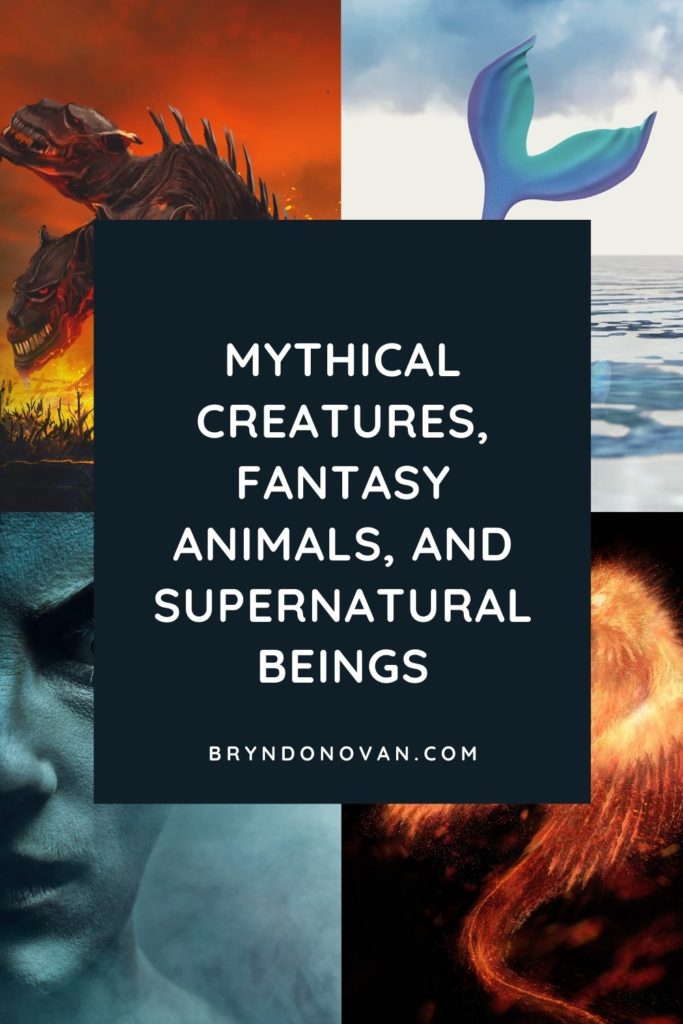
abiku – among the Yoruba and Dahomey people in West Africa, these are evil tree spirits that are born as children and die several times, often within the same family. I could be wrong, but I think the ogbanje are basically the same thing.
angels – they show up in Judaism, Islam, Christianity, Sikhism, and other traditions of belief. To millions of people around the world, these aren’t mythical creatures at all, of course, but very real divine beings.
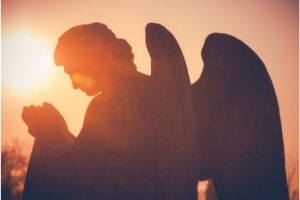
bakru – these little gnome-like people in Suriname are half flesh and half wood. They will do your dirty work for you if you enter into a pact with them — which is a terrible idea.
banshee – you’ve probably heard the expression “screaming like a banshee,” but you may not have known exactly what these supernatural creatures are. They’re Irish female spirits, and if you’re about to die, one will show up to wail at you. The Slavic božalość are pretty much the same thing.
barghests – giant demonic dogs with huge teeth and claws who live in northern England. One of these fantasy creatures shows up when you’re about to die. Some creatures like this are simply referred to as Black Dogs.
basilisks – these reptiles can kill a person with a single glance. Sometimes people call them cockatrices.
brownies – in England and Scotland, these are little people who are loyal to human households and will sometimes help out with the chores. You don’t want to make them mad, though. Fans of Harry Potter and the wizarding world, take note: a dobbie or dobie is a kind of brownie, and an angry brownie can turn into a boggart.
btsan – the btsan are fierce sky spirits in Tibet that look like red hunters riding red horses.
Cerberus – this is one of the most dangerous or evil Greek mythological creatures: a three-headed dog that guards the door of the Underworld in Greek mythology.
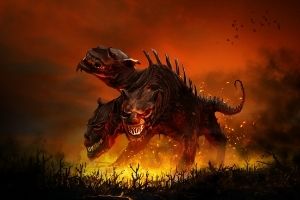
chimera – in Greek mythology, the chimera has the body and head of a lion, a goat’s head sticking out of its back, a set of goat-udders just for fun, and a serpentine tail. (By the way, the term chimera also refers to something you’re hoping for, but is impossible to achieve.)
changeling – many European countries have stories about the fairies or trolls stealing human babies and leaving sickly or malignant magical babies in their place. These myths have some similarities with the abiku, above.
Cloud People – also known as the Shiwanna. In Pueblo Native American traditions, these are supernatural beings from the underworld who bring rainfall.
Co-hon – in Vietnam, these are the spirits of people who died a violent death and weren’t buried with ceremony. They bring bad luck to people who pass by them unless they are appeased.
Coraniaid – the Coraniaid are Welsh dwarves with very sharp hearing who are immune to weapons. They use fairy money, which looks legit but soon turns into toadstools.
Cwn Annwn – Welsh hellhounds. They’re white with red ears, and gather up souls and drag them to hell. (See also: Dando’s Dogs.)
dæmons – (also spelled daimons.) These not the same thing as demons. In ancient Greek mythology, they were helpful spirit guides, similar to guardian angels.
demons – obviously, no list of supernatural creatures would be complete without these guys. They’re most often depicted as humanoid creatures, and in Western culture, they frequently have horns. Variations of them appear in ancient near East religions, Judaism, Hinduism, Islam, Christianity, and other faiths. Here’s a fun list of some of the worst ones, and a here’s a list of many or all of the demons with names.
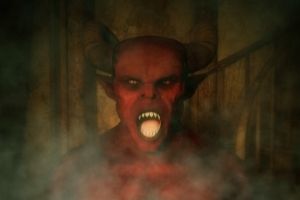
dodore – these are little people in the Solomon Islands have one eye, one leg, and long red hair, and they don’t seem to be friendly.
djinn – these are supernatural beings of Arabian mythology who can be conjured up for aid. However, they are malicious tricksters and shape shifters. There are a few different classes of djinn, including the afrit (also spelled ifrit), who are large beings made out of smoke. Djinn are often associated with the desert.
dracae – singular “drac.” These weirdo water spirits in England take the form of floating wooden dishes. If women passing by think, “Yay! Free dishes!” and try to grab one, the dracae drag her under the water and make her their nanny forever.
dragons – these awesome fire breathing creatures must be one of the most famous fantasy animals of all, and they appear in the mythologies of Europe, the Middle East, and Asia.

dryads – tree nymphs in Greek mythology.
dwarves – most of them come from Norse mythology, but there are also Teutonic dwarves, Slavic dwarves, Welsh dwarves (see the Coraniaid, above), and other kinds. Dwarves are almost always miners and/or smiths who live underground.
duende – the Spanish word “duende” has an abstract meaning that I find hard to grasp, even though I’ve read plenty of Federico Garcia Lorca. However, the duende are also pixie-like creatures who may either get you lost in the forest, or help you find your way home, depending on the story. In some other tales, they hide in the walls or under your bed, accidentally cut off kids’ toes in attempts to clip their toenails, or just give people nightmares.
elves – this is probably one of the best-known supernatural species, and there are so many different kinds. This link discusses the álfar (singular, álfr) — light-elves in Norse Germanic mythology, which clearly inspired Tolkien — as well as some other types.
emandwa – these protective household spirits in Uganda are loyal to families and help women to be fertile.
encantados – in Brazil, this can refer to shape-shifting dolphin men who live in an underwater realm. In the vodou religion, the word has a different meaning.
fairies – dozens and maybe hundreds of cultures across the world have myths about magical, tricksy little people, a few of which are called out separately on this list. Fairies have often been depicted as cute fantasy creatures, but in some tales, they’re a bit more sinister. Here are links to read about English fairies, Irish fairies, and fairies on the Isle of Man. There’s some discussion of Italian fairies, or “fatas,” in this article about Italian witchcraft.
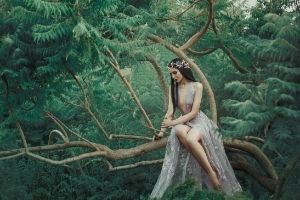
fauns – C.S. Lewis may have introduced you to these half-human, half-goat forest pals. They are Roman in origin, and this article discusses the difference between fauns and satyrs.
firebird – in Russian mythology, this bird has feathers that glow in the night.
flagae – (singular, flaga) – this spirits have their roots in medieval Europe. If you are a witch, you can make them show up in your mirror and tell you about the future.
fuaths – these ugly little jerks live in bodies of water in Scotland and play tricks on you or try to sink your boat. You can kill them with sunlight or steel.
gahe – also known as the Mountain People, because they live inside mountains. According to Apache beliefs, these spirits have healing powers.
ganas – in Hindu mythology, these are different kinds of supernatural beings in Lord Shiva’s entourage (though Ganesha, the elephant-headed god, is their boss.)
gandharvas – Gandharvas are male nature spirits who are, among many other things, wonderful singers and musicians. They figure in both Hindu and Buddhist mythology.
gnomes – these humanoid creatures are somewhat similar to dwarves, but they don’t live underground, and they wear cute peaked red hats. Garden gnomes are a particular subset of gnomes, and you can read more about them here.
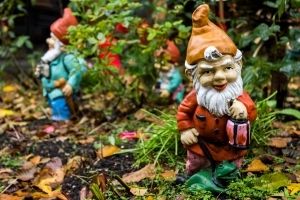
goblins – these European creatures can be very short or human-sized, and they are as ugly as they are mean.
gremlins – the British Royal Air Force blamed equipment failures and such on magical troublemakers called “gremlins,” but they were just as likely boggarts or goblins.
gryphons – also spelled griffins. These medieval fantasy creatures have the head, talons, and wings of an eagle and the body of a lion.
hag – in some European tales, a hag is a supernatural being that takes the form of a crone. Some hags sit on people when they’re sleeping and give them nightmares.
harpies – in Greek and Roman mythology, these are vengeful wind spirits. They have the heads and torsos of ugly women, long talons, and bird bodies.
Hesperides – these Greek nymphs are associated with the light of sunset, and they guard a sacred tree of golden apples.
hobgoblin – like a brownie, but more into playing practical jokes.
hongaek – this Korean word means “Red Disaster,” and describes a cloud of fear and confusion that shows up at the scene of a suicide, murder, fatal traffic accident, or other catastrophes. The cloud infects people and brings them bad luck.
hu hsien – in Chinese mythology, these are shapeshifting foxes who turn into gorgeous women.
hydra – the terrorist organization in Marvel Comics is named after an ancient sea monster in Greek and Roman mythology. It has many heads, and if you cut one off, it grows two more in its place.
hyter sprites – awwww… these green-eyed fairies in East Anglia, England can shapeshift into sand martins, and they help lost children get home.
igigi – in the mythology of ancient Mesopotamia, these spirits hovered above the earth’s horizon and, like angels, helped the deities.
incubi – (singular, incubus) – these are male evil spirits that have sex with women while they are sleeping and impregnate them. In medieval England, an incubus can shapeshift to look just like a woman’s husband or lover. However, in his natural state, he has cloven hooves. In a few variations, the incubus can take a male or a female form. Many cultures have their own version of the incubus.
javerzaharses – these Armenian nymphs sometimes have wings. Their name means “The Perpetual Brides,” and they are involved with planning wedding ceremonies.
kaches – in Armenian tales, these mean spirits hide in rocks and trap and torture humans.
kakamora – in the Solomon Islands, these little people have long hair, long teeth, and long nails. They hide in caves and banyan trees, and either eat people or play tricks on them, depending on who you talk to.
kanaima – in Guinia, these avenging spirits can possess people.
kitsune – “kitsune” is Japanese for “fox.” In some Japanese tales, foxes have magical powers and can shapeshift into women. The more tails a kitsune has, the older and more powerful she is.
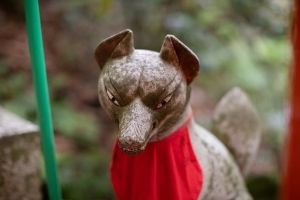
kupua – these are supernatural tricksters in Hawaiian mythology. They are versatile shapeshifters.
keshalyi – Transylvanian fairies. It doesn’t get any cooler than that. They appear in Romani folklore.
kobolds – these little German guys might live in mines or in your house. They have similarities to brownies and to dwarves.
Korrigan – in northwestern France, these elf-like female beings have long hair, flowing white garments, and sometimes delicate wings. Their songs and firelit dances can lead travelers astray.
knockers – also called “Tommyknockers,” these mine spirits live in Cornwall and sometimes in the U.S. (I believe some emigrated). They are similar to kobolds and to dwarves.
leprechauns – these famous little bearded shoemakers in Irish tales sometimes hide pots of gold at the end of rainbows. I don’t know if this is true in other countries, but in the United States, we associate these cute fantasy creatures very strongly with Saint Patrick’s Day.
limoneads – I know, it looks like “lemonheads.” These ancient Greek nymphs protected meadows and fields of flowers.
Loch Ness monster – this is one of the more famous mythological creatures: a long-necked water creature said to inhabit Loch Ness in Scotland. Its legend goes back to the year 564.
ma-mo – female disease demons in Tibet who dress entirely in black.
matabiri – nasty swamp spirits in Papua New Guinea.
matagaigai – malevolent tree spirits, also in Papua New Guinea. The females have one big breast and one small one.
mermaids and mermen – dozens of cultures have myths about these half-human, half-fish creatures.

minotaur – in Greek mythology, this monstrous creature with the head of a bull lived in a maze. King Minos offered it regular sacrifices of young people to feed his hunger.
moksin tongbop – in Korea, these wood imps can hide in an armload of firewood and come into your house, where they will cause disease and misfortune.
Muses – in Greek mythology, these nine nymphs or goddesses are patronesses of the arts.
nats – these tree spirits, sometimes worshipped in parts of Myanmar, may guard the environment.
nixies – water spirits in Germany, Scandinavia, and Switzerland.
norns – also called the nornir, these are the three Fates in Norse mythology.
phoenix – this long-lived bird stars in the mythologies of several ancient cultures. After hundreds of years, he spontaneously combusts, and a new baby phoenix is born in the ashes.

pixies – red-haired fairies from Cornwall, England, with turned-up noses like pigs.
poltergeists – spirits of the dead or malignant forces that live in some houses and throw things around. The name means “noise spirit” in German.
saba-leippya – this is actually a sub-category of nats (see above), but they are so lovely I had to call them out specifically. They are guardian spirits of rice paddies. One is assigned to each field, and they take the form of butterflies.
salamanders – these are real lizards, but they also have legends associated with them. European medieval philosophers said that salamanders could create and put out fires.
selkies – most cultures have shapeshifter stories. In Orkney, the selkies are seals who can turn into humans.
skinwalkers – in Navajo mythology, a skinwalker can take on the appearance of any person or creature, and they can be terrifying.
Sphinx – in Greek and Egyptian stories, the Sphinx is a man eating creature with a human head and a lion’s body who likes to ask people riddles, and then devour them if they don’t know the answer.
succubi – (singular, succubus) – in European tales, these female demons have sex with sleeping men.
sylphs – these supernatural creatures are elemental, delicate spirits of the air. They be the souls of women who died as virgins. From medieval European mythology.
trolls – unlike Internet trolls, these legendary creatures of Scandinavia and England are useful once in a great while. Mostly they’re malicious, and most people agree that they’re hideous.
undines – beautiful but soulless female water spirits, according to medieval European tradition.
unicorns – I don’t really need to explain these medieval fantasy creatures. Click the link to find out about the nine times they are referenced in the Bible, among other things.
Valkyries – finally we get to my favorites! Their name means “Choosers of the Slain,” and they show up at battles to decide who will die. Then they escort the souls of the chosen back to Valhalla, where everyone has a good time.[spacer height=”20px”]

vampires – forget about sparkling — in all the old stories, vampires are beyond disgusting. This site has a pretty good breakdown of vampires and vampire-like creatures from different cultures. Most of our modern vampire lore comes from early 18th century Eastern Europe, when everyone lost their minds, claimed to see vampires, and tried to stake and kill them. (You can read about one case here.) The vampires in Romanian mythology are called the strigoi.
veela – Also spelled vila. These ladies are beautiful mountain nymphs of Serbia who like to dance in the forest under the light of the moon.
wendigos – in Native American mythology, these giant creatures was once human, but turned into lanky, hairy monsters after they resorted to cannibalism. They roam the woods looking for more people to eat.
werewolves – wolves are some of the most common kinds of shapeshifters in folklore. Here’s a pretty comprehensive werewolf site, and you can read about Louisiana’s loup-garou here.
winged horses – there are many of them, from a few different cultures, besides the famous Pegasus.
Zduhać – in Slavic mythology, these were men with the natural magical ability to protect their people and their property from storms and hail. During sleep, they could leave their bodies to do battle with the evil spirits who caused foul weather.
I hope this mythical creatures list serves as good reference and inspiration, and if you happen to be an expert on one of these magical creatures, please share more information in the comments!
If you’re planning a fantasy or supernatural novel (or a trilogy or series!), you might like to order my book Blank Page to Final Draft. It’ll take you step by step through planning, writing, ane editing a novel to get to a polished, ready-to-publish version. Check it out!
If you don’t want to miss future lists for writers, follow the blog, if you aren’t already — there’s a place to sign up below.
Thanks so much for reading, and happy writing!


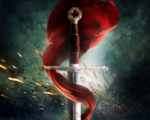

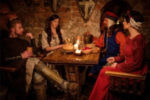
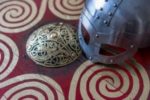
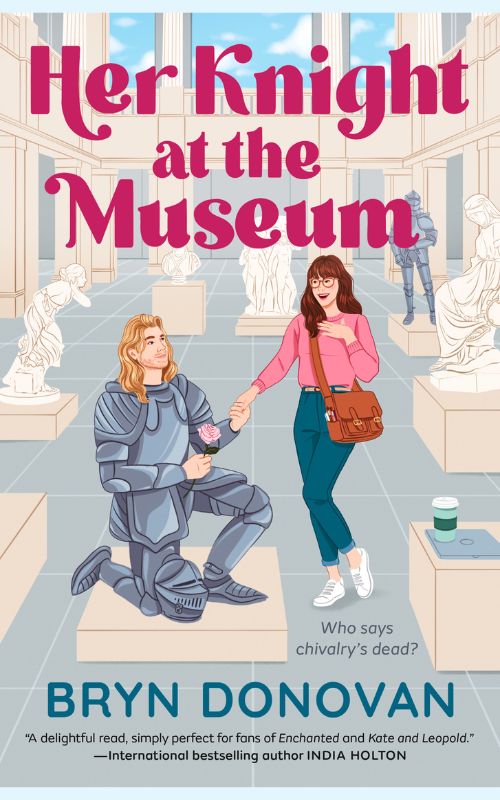

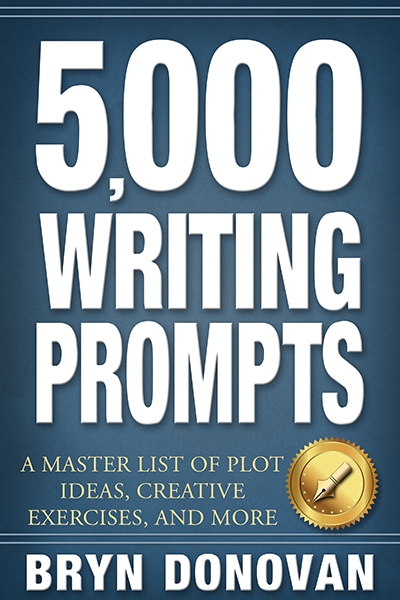

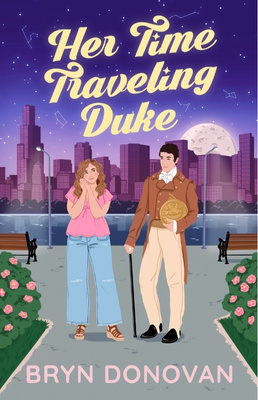

I’m using the Chupacabra myth h in the Sea Purrtector Files Series.
Ooh, I should have put chupacabras on here! I may add them. Those are great 🙂
They make an excellent villain for a Caribbean-based story…. at least they work in this series 😉
No Manticore? Aww.
🙂
Excellent! This makes me want to put some creatures in the book I’m outlining for NaNoWriMo, though the thought hadn’t crossed my mind until right now. That might actually help me with the plot…
Have you seen Borges’s Book of Imaginary Beings (if I’m recalling the name correctly)? It’s a whole book of this. Though I always suspected he made up some of them himself.
Robert Bly has a good essay on the duende and its importance in poetry, in American Poetry: Wildness and Domesticity. That essay, and the whole book, have really influenced me as a writer (for better or worse, heh heh).
You’re doing NaNoWriMo? That’s fantastic!
I haven’t seen Borges’s book! I would be surprised if he didn’t make some of them up. 🙂 I stopped on this list when I realized I didn’t have a good way to decide what to include and what to leave out.
I will have to check out the Bly essay, too. That book sounds great!
This is a great list! I love mythological creatures.
My WIP has kitsune and will probably feature a few other creatures from Japanese mythology before the tale is finished.
Kitsune are so cool. That sounds like a fun project!
The kitsune are my favorite part of the story. The rest of it is giving me a lot of grief in this draft, but it’s worth it.
I have a story with what I call Kyubi, human like people that turn into foxes that have one or two tails at birth. The leader has 9 tails after a rebirth. It is similar to the Kitsune. They also tend to have fire magic and psychic abilities. They are often hated due to what many see as pathological lying. At least my version of them. I am not sure if that is normal or not. 🙂
A Kumiho is kind of the Korean version of the Chinese Hu Hsien and Japanese Kitsune. A fox that lives a thousand years turns into a Kumiho. It can freely transform (among other things) into a beautiful woman often set out to seduce males, and eat their liver or heart (depending on the legend).
Ah, that’s fascinating. Thank you!
Thank you so much for this list. I’m gearing up for Nanowrimo and have my story sorted out and ready to go for November 1st. And as I was going down the list I came across one that not only is perfect for plot but ties in with my MC and now the story has quite a twist to come. Reblogging on my blog “The Depths of my Mind” because it is such an amazing resource to have for paranormal writers.
Oh, thank you for sharing! I’m so glad it’s helpful! I love paranormal stuff, so this was right up my alley 🙂
Looking back on this post, I’m not sure its clear that you can click on the creature names to go to a link with more info? I need to edit and make that more clear 🙂
I was able to tell you can click on the names. Need to take the morning and go through this list more in depth . I’m sure there are a plethora of story ideas to be discovered.
Reblogged this on From the Depths of my Mind and commented:
Check this master list out of mythical creatures and beings to give you some ideas for your next paranormal/supernatural story.
Hi! Great list!
Don’t you mean Federico Garcia Lorca in the duende entry though?
Yes! Kinda surprised no one caught that sooner 🙂 Fixed it!
great list ma’am! But I would like you to add more mythological beasts from China 😀
Reblogged this on Hazel vixen's Blog and commented:
List of Mythical Creatures
Great article! Thank you for it! Although I was born and raised in Transylvania I’ve never heard of keshalyi fairies, but as you said, they are from gypsies folklore and I never talked with one in my life. I’m going to research a little and see what I can find about them. Anyway, we have in Romanian folklore a correspondent for veelas, that we call iele (ielă is the singular). We see them as ‘bad fairies’ because they dance in the night in circles and whoever sees them is cursed. Also, in the morning the grass is burned in the place they danced. The good fairies are called sânziene or simply zâne (=fairies in Romanian).
Hi Ioana! I would love to visit Transylvania someday. It seems so beautiful and so much interesting lore comes from there!
I never heard about the iele before — that is so cool! I love learning the Romanian word for the good fairies, too.
Thank you so much for commenting!
Thanks so much! I’m currently writing a fantasy book which includes a huge parade of magical creatures, so this was a golden list for me.
Oh, so glad it was helpful, Kiete!
You want to hear something funny — I worked hard on this list and after I first posted it, I shared it with an online writing group. Immediately two people complained that it wasn’t good enough and I almost took down this blog post as a result! But I left it up and it turned out a lot of people liked it. 😀
I think you should never take a post down, just because there are some people that don’t like it. There will always be people who do like it (like me).
Besides, I hope to be on time for the next WIP Wednesday, I really want some feedback on a fragment of that fantasy book, I’m dutch and I’m not entirely sure about my use of certain english words. 🙂
Oh, I hope you do share at the next WIP Wednesday! Let’s see… it’s April 6, you’ve got lots of time. 🙂 Your English is excellent!
Shout out to my kingsman and Bryn, don’t forget about the month of spring or this winter will never end.
Thank you for making this list. I’m currently writing the first book in what I hope will be an exciting fantasy series, and this is going to help me more than you know. You can spend hours searching on google, but you compressed it all right here in your post. Reading your list has sparked lots of ideas for plots. Thank you again.
Hello!
A nice list but if you want to update it some here is some suggestions from the Norse folklore:
The Myling: Its the spirit of an infant killed by it’s parents (often the mother) for various reasons. Due to the trauma of it’s death (drowning is a common method) the soul of the child haunts the area to find comfort. The child will scream and cry after a chance to rest in peace, this can be achieved if one “carries” them to a graveyard, the task will get heavier and heavier the closer you get to your goal. If you fail ad give up, it will rip you apart.The myling can also be freed if it’s breastfeed by its mother, but she will not be spared.
The Brookhorse/ the Neck: Two indifferent waterspirits that lure it’s victims to drown. The horse by fooling people to ride it’s back and the Neck by playing his violin.
The Huldra/Skogsrå: same creature, a beautiful guardian of the forest. She will often be dressed in a dirty white dress, to hide the wooden hole in her back and her cow/foxtail (depends on region.) Can both be helpful and aggressive depending on how you treat the woodlands.
greetings from Sweden
//Julia
Julia, these are wonderful! I had not heard of any of these. Thank you so much for sharing!
Thank-you, Bryn! I really appreciate you compiling this list. I am doing a 895 km hike on the Bruce Trail, which is the longest foot trail in Canada. It stretches across the Niagara Escarpment from Niagara to Tobermory. On my travels, I have begun to see the many “faces” in the forest and they have started to tell me their story. In my writing of these mystical sights, I began searching for creatures in the forest that I could reference to in order to re-tell my adventure in the way that I see it. As you said, the list of creatures goes on endlessly and I am so glad to have found your site to narrow it down. Thanks again!
Annette, that sounds like an amazing hike! And I love it that it’s inspiring your creativity! There are so many myths from different cultures about forest spirits and forest people… But most of us are so out of touch with that kind of connection with nature these days. What a fantastic experience that must be.
Shahmaran, should be in there She’s snake king half snake half human, her down actual body is a head of a snake
Her beauty will lead you to death.
Oooh, never heard of that one. That is great!
This is so amazing. Thanks!
Thank you Deli, I’m so glad you like it!
Thanks for this great article and collection.We have several here in the Caribbean, especially my home country Jamaica. I note that some of them are found in other cultures too such as mermaids. Some of ours include:
Three-feet horse
Duppy (terrible ghosts)
Whipping boy (Spirit of the slave whipper)
Sweetie man (One who lore children with sweets
Rolling calf (dead butcher who becomes a fiery cow)
Mermaid (Called Myamaid or River Mumma in Jamaican Patois)
Old Higue (Similar to Hag or a Baba Yaga)
Anansi (also spelt Anancy or Ananse, is a trickster spider)
Big Head, Big Belly and Fine Foot (The three naught kids)
Big Boy (Called Big Bwoy in Jamaican Patois, he is always doing naughty things to females)… among others
I am currently in the process of developing the plot line for my story, and I need a species for a boy character. If you have read the books Eragon, Eldest, Brisinger, and Inheritance, you learn about a species called Urgals. I want something similar to them (usually big, appearing brutish, very misunderstood culture, fierce warriors, etc.) But I have been having trouble identifying creatures that would work. Another thing that would work is just comming up with a name that would work with what I want in this character, and this characters species. Do you have any suggestions? Any would be very helpful. Thank you.
P.S. I found some possible ones, but I am not sure if they would work. They are:
Fomorian
Ogre
Orc
Cyclops
But I would rather do something else. Thank you.
I am currently in the process of developing the plot line for my story, and I need a species for a boy character. If you have read the books Eragon, Eldest, Brisinger, and Inheritance, you learn about a species called Urgals. I want something similar to them (usually big, appearing brutish, very misunderstood culture, fierce warriors, etc.) But I have been having trouble identifying creatures that would work. Another thing that would work is just coming up with a name that would work with what I want in this character, and this characters species. Do you have any suggestions? Any would be very helpful. Thank you.
P.S. I found some possible ones, but I am not sure if they would work. They are:
Fomorian
Ogre
Orc
Cyclops
But I would rather do something else. Thank you.
Maybe you can invent the species? That way you can create them just the way you need them. Hope that helps a bit!
Hi
I am in the process of writing a book. I am struggling with the central theme. Would love some ideas for a mystical water character. Needs to be pure and good.
Blessings
Luna
Naiads are water nymphs. They embody diverse body of fresh water.
I think ondines are also a type of nymphs, the sea I think.
Oreads are the mountains and naïads are from the rivers.
Hi Bryn. This is a great help. ??
If I may share, I came across a Filipino site: https://www.aswangproject.com/
That site is a database of Philippine folklore creatures which are rich in stories. You might want to check it out too.
What about Wights?
Hi, Stuart! Hey, it’s not a comprehensive list! 🙂 But wights are great story fodder, so you make a good point!
two things Ur missing gorgons and Ganesha is not the leader of anyone that is shiv and ganas are a misinterpretation who is the father of Ganesha i follow Indian traditions and i kind of know things like this im just a kid who likes to write though
Hi, Im doing a free write for my 7 grade language arts class. I am writing a book about five girls who when they come in contact with certain things may become a certain mythical creatures. for example “ Ali Turner”turns into a mermaid when skin is in contact with water.
Here’s a challenge: what was/is the mythical creature that was distinguished by a huge grinning mouth-full of teeth? It’s name starts with an “m” and spelled something like “maniche,” but that’s not it. The woodcut print I recall seeing of it depicted it in a tree, grinning the monstrously toothy grin and poised as about to pounce. Kinda like the Cheshire Cat, but it wasn’t a feline creature.
(Actually I first encountered mention of it in a derisive article about Juilie Roberts. It fit. And I always think about that when I see a photo of her.)
You’re thinking of the manticore, I do believe.
Hi, great list. Quick note about the Brownie entry. The Harry Potter creatures you referred to are called house elves; ‘Dobby’ is the name of one character.
As a young starting out writer trying to start up a fantasy story, this is absolutely fantastic!
What a wonderful list! Thanks a lot, also for prompting an idea for a short story! By the way, I love your blog!
Oh, thank you, Natalie! I’m so glad it was inspiring. Thanks for reading my blog!
thank you so much for this list. I needed some unique species for a roleplay and this really helped. <3
Excellent list! I know some of them already, yet will now go and bookmark it. I do recommend the book “Encyclopedia of Spirits” by Judika Illes. It’s my main resource for for, at least, non-corporeal creatures. It’s a huge book, and worth having around as a reference and source of inspiration.
This list is a life saver! I’m beginning to write, and I’ve hung onto an idea for a science fiction story. I had originally planned for it to be about the normal brought up supernatural creatures, but considering that i decided to write about a prestigious supernatural academy. I decided on branching out on the different creatures in the story.
Brownies in Slavic mythology are called Domaći or Domovo(j)i, which can be roughly translated as [spirits] of the home.
Hello Bryn, In your opening you do state that most of your mythical creatures are North American, European etc. but you do include the Huli jing Fox Lady of Chinese mythology. I don’t know too much about the mythical folk you mention asmy interests are almost solely about Chinese/Asian ‘spooks’. A couple you may be interested in are Jiangshi the Chinese version of a Zombie. Personally, I think the Zombie is a over done now-a-days. Just another Chinese ghost is E Gui, the hungry ghost. Hungry Ghost Festival is held in Asia every year.
One spook I learned of from a South African friend of min only recently is the Tokoloshe a dwarf water spirit who can vanish if it drinks water.
There is a guy with a Blog who hails from your neck ‘o the woods.
https://chinesefolktales.blogspot.com/2010/01/
He has some interesting stories.
Hi, Peter! These all sound so interesting. Thank you for the info, and for the links! I really appreciate it!
I scanned the comments but did not find ‘golem’ on your EXCELLENT list. https://en.wikipedia.org/wiki/Golem
This list is incredibly good! It’s served as a great tool for my world building. You’ve narrowed the list down to the essentials with mythical creatures yet provided us with plenty of creatures and information. It’s a perfect list. Thank you 🙂
I’m trying to write a supernatural fanasy book and this list helps me alot with the supernatural creatures I’m to be putting in it, thank you so much it is great
also Fae
i am preparing for JRF. I was helpful for me. can you make a list of animals who are used as symbols and their publishing date? Please 🙂
Basilisks are snakes/serpents where’s as cockatrices have the head and talons of a chicken, bats wings, and a serpent body!
i think this is a great list but I think some essential creatures should be added: like I saw a comment about cockatrice: ESSENTIAL! The only mention of it is under ‘basilisk’. There’s a difference. Sorry, this comment is coming out negative, but this list is really really helpful in my writing (and my overall interest in mythical beings) and thank you so much for making this!
In Australia we have our own kind of Bigfoot known as a Yowie, many very tired interstate truck drivers on long hauls tell terrifying stories of encounters with these beings, including dismantling of their rigs while they are in them!!
We also have the little people (hairy, scary, evil) in the Endeavour River area of North Queensland Known as Quinkins.
As our early immigration of convicts from the UK brought with them most of their spirits.. we have a smattering here .. like Water Sprites, Banshees, etc..Various little people, Pixies, Elves & Fairies etc. . .
We also have had some really frightening ACTUAL animals that existed in the past, such as the Thylacine – A Dog/Hyena type creature with Tiger stripes( also known as the Tasmanian Tiger). There are occasionally still REPORTED sightings of Thylacines today in Tasmania in the Western Wilderness- but no proof. The last died in the early 1900’s in a Zoo.
The Queensland Marsupial Lion resembling the Sabre Tooth tiger- was terrifying in it’s day. Some other ANIMALS that were thought to be extinct – have been found here and there – 1 of those here in Queensland is the Phascogale (the vampire marsupial) whose favourite animal to drain of blood night after night is chickens, who eventually die- and has many younger farmers scratching their heads.. but the old timers 80+ years know who the culprit is. And they are back in increasing numbers after not being seen for decades. They are small rather cute possum like creature with very bushy long tail and long teeth. One of my stories features these creatures after listening to hours of stories from a vet who experienced them first hand in a western queensland region, spending weeks camping out to figure out what was happening to the chooks in this region.
Super article! Thanks for sharing this article, this article is very well written.I found a cool dragon necklaces & dragon rings on The Dragon Will
From primitive times people have regarded the dragon as an auspicious creature with the power to bless and influence their lives. As tribes fought for domination and came to be united under a common banner the dragon was adopted as a national icon. Such was the mysterious creature’s power it was regarded as the god of rain, thunder, the rainbow, and the stars.They are among the most powerful creatures on planet Earth, due to their giant size. Dragons can fly, breathe fire, and are extremely powerful, strong, and intelligent creatures. Their hard scales cannot be easily pierced by swords, arrows, and other weaponry. Dragons also have deadly poisons in their teeth and claws.
The most common dragon to appear in British folklore and perhaps the earliest root of the dragon legend is the worm,which stems from Norse influences and the Anglo Saxon word Wyrm or vurm. In appearance the worm is wingless and scaly with no arms or legs, very similar to a gigantic snake but with the added dread of poisonous breath, and the ability to rejoin after being cut into pieces. These great worms were often the metal to test the courage of aspiring heroes. The Lambton worm was one such creature as was the dragon of Loschy Hill. As well as being the making of young heroes, dragons often have other similarities within folklore. They are often associated with the guarding of treasure(or captive maidens), and with sacred wells, hillocks. Springs and deep caves. This may have some relation to ancient religious beliefs and mythic patterns, and esoterically dragons have been linked with the belief in earth energies and chthonic subterranean forces.
The most common dragon to appear in British folklore and perhaps the earliest root of the dragon legend is the worm,which stems from Norse influences and the Anglo Saxon word Wyrm or vurm.
I am using a lot of monsters and supernatural creatures to invent and write my own story
Yeah, an Ogbanje is the same as an Abiku. While the Yorubas call them “Abiku”, the Igbos call them “Ogbanje”.
Keep like this admin, thank you so much.
You should add nymphs and nickels.
People who are accused of crimes under federal law must navigate a challenging and complicated legal system. A Federal Criminal Defense Lawyer’s experience is essential when facing accusations of federal offenses since they can have far-reaching and life-altering effects. These attorneys are vital supporters who work to protect the rights of the accused and maintain an equitable and just legal system.Abogado Federal de Defensa Criminal
If you’re planning a fantasy or supernatural novel (or a trilogy or series!), you might like to order my book Blank Page to Final Draft. It’ll take you step by step through planning, writing, ane editing a novel to get to a polished, ready-to-publish version. Check it out!
Perhaps you should edit your page? Maybe “and” would be better than “ane”?